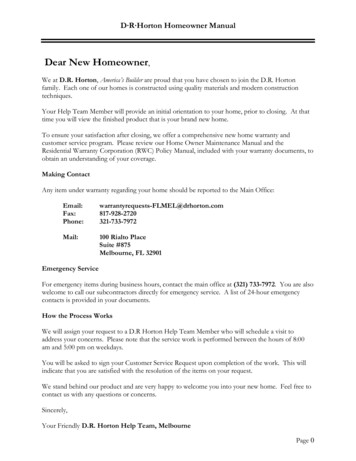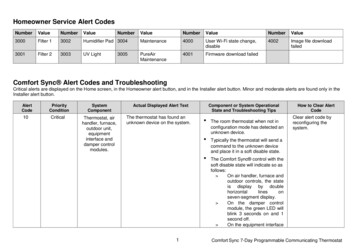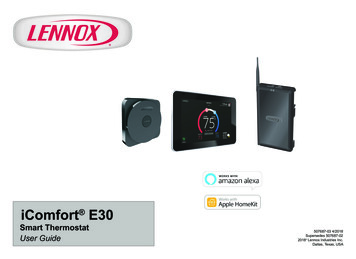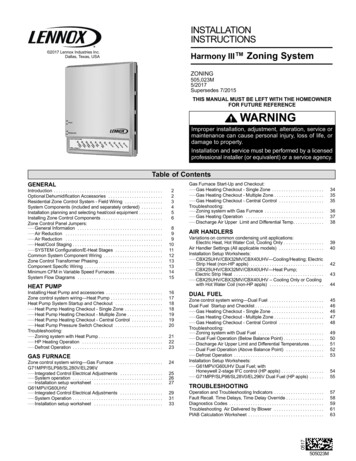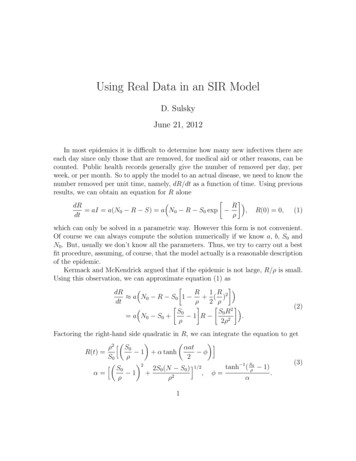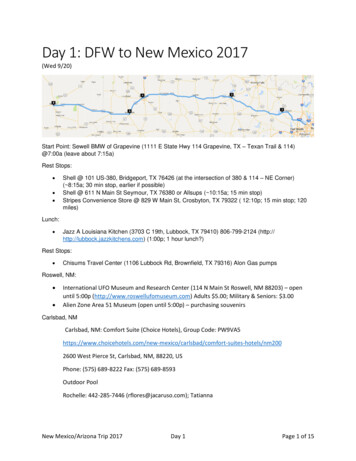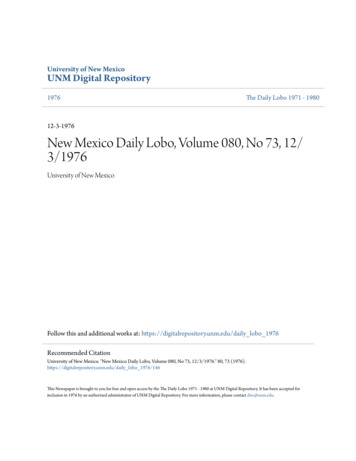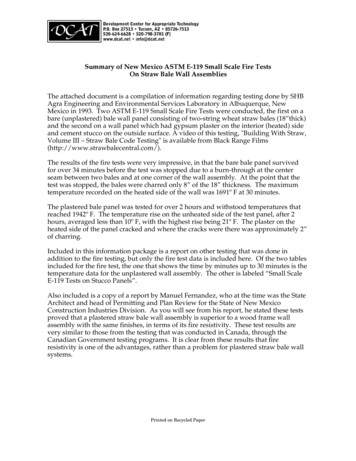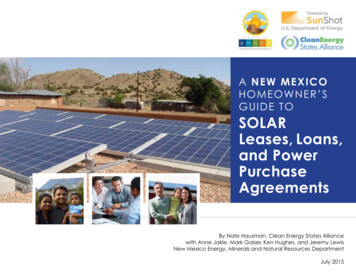
Transcription
A N ew Mex ic oH O ME O WN E R’ SGUI D E TOSOLARLeases, Loans,and PowerPurchaseAgreementsLeases, Loans, and PPAsBy Nate Hausman, Clean Energy States Alliancewith Anne Jakle, Mark Gaiser, Ken Hughes, and Jeremy LewisNew Mexico Energy, Minerals and Natural Resources DepartmentJuly 2015
acknowledgementsClean Energy States Alliance (CESA) prepared this guide through the New England Solar Cost-ReductionPartnership, a project under the U.S. Department of Energy SunShot Initiative Rooftop Solar Challenge II.The U.S. Department of Energy SunShot Initiative is a collaborative national effort that aggressively drivesinnovation to make solar energy fully cost-competitive with traditional energy sources before the end of thedecade. Through SunShot, the Energy Department supports efforts by private companies, universities, andnational laboratories to drive down the cost of solar electricity to 0.06 per kilowatt-hour. Learn more at energy.gov/sunshot.The Energy Conservation and Management Division (ECMD) of the New Mexico Energy, Minerals and NaturalResources Department develops and implements effective clean energy programs — renewable energy, energyefficiency, alternative fuels, and safe transportation of radioactive waste — to promote economic growth,environmental sustainability, and wise stewardship of New Mexico’s natural resources while protecting publichealth and safety for New Mexico and its citizens. For more information, visit http://www.emnrd.state.nm.us/ECMD/.Special thanks to Lise Dondy for her help conceptualizing, preparing, and reviewing this guide. Thanks tothe following individuals for their review of the guide: Maria Blais Costello (Clean Energy States Alliance),Bryan Garcia (Connecticut Green Bank), Janet Joseph (New York State Energy Research and DevelopmentAuthority), Elizabeth Kennedy (Massachusetts Clean Energy Center), Emma Krause (MassachusettsDepartment of Energy Resources), Suzanne Korosec (California Energy Commission), Warren Leon (CleanEnergy States Alliance), Jeremy Lewis (New Mexico Energy, Minerals & Natural Resources Department),Le-Quyen Nguyen (California Energy Commission), Anthony Vargo (Clean Energy States Alliance), Marta Tomic(Maryland Energy Administration), Selya Price (Connecticut Green Bank), and David Sandbank (New YorkState Energy Research and Development Authority).DisclaimersThis material is based upon work supported by the U.S. Department of Energy under Award Number DE-EE0006305.This report was prepared as an account of work sponsored by an agency of the United States Government. Neither the UnitedStates Government nor any agency thereof, nor any of their employees, makes any warranty, express or implied, or assumes anylegal liability or responsibility for the accuracy, completeness, or usefulness of any information, apparatus, product, or process
contentsIntroductionpg2Financing for theResidential SolarMarketplacepg3What You Needto Know aboutLeases, PPAs, andLoansCommon Terms inSolar Financing8pg5pgWeighing theBenefits of DirectOwnershipversus Third-PartyFinancingQuestions to Askpg17Solar FinancingResources forHomeownerspg2113pg1 A N EW MEX I C O HOM E OWNE R’ S GU ID E T O SOLAR FINANCING
introductionAre you thinking about installing a solar photovoltaic (PV) system on your house and are trying to figure outhow to pay for it? Perhaps you are debating whether to purchase the system outright or take advantage ofa financing option. Perhaps you do not yet know which financing options are available to you.If you are thinking about going solar, there is good news: The price of a solar PV system has come downdramatically in recent years, and there are more ways to pay for it. But with so many solar financingoptions now available, the marketplace for these products has become increasingly complex. It can behard to choose among the different packages and vendors. The differences between them may not bereadily apparent. Some contracts are filled with confusing technical jargon, and key terms can be buriedin the fine print of a customer contract.This guide is designed to help homeowners makeinformed decisions about financing solar.This guide is designed to help you make informed decisions and select the best option for your needsand finances. It describes three popular residential solar financing choices—leases, power purchaseagreements (PPAs), and loans—and explains the advantages and disadvantages of each, as well as howthey compare to a direct cash purchase. It attempts to clarify key solar financing terms and provides alist of questions you might consider before deciding if and how to proceed with installing a solar system.Finally, it provides a list of other resources to help you learn more about financing a solar PV system. Theguide does not cover technical considerations related to PV system siting, installation, and interconnectionwith the electricity grid,1 nor does it cover all of the particular local market considerations that may impactfinancing a PV system.2 A N EW MEX I C O HOM E OWNE R’ S GU ID E T O SOLAR FINANCING
financingOptions for HomeownersThe size of a residential solar PV installation can vary dramatically, but in New Mexico, it isgenerally between 3 and 8 kilowatts (kW) depending on a variety of factors, including the availableroof space (or ground space if it is a ground-mounted system), site conditions such as roof aspectand shading, the electricity usage of the home, and available financing.2 To put these system sizesinto context, a 4 kW system in New Mexico produces slightly more electricity than the average NewMexican household uses in a year.3A system’s size is unsurprisingly a key determinant of its cost.4 While the price of systems variesconsiderably, a residential solar PV system in New Mexico usually costs between 13,000and 30,000, roughly the same as a new car.5 Just as buying a car outright can be financiallyburdensome for many automobile customers, so too can paying the entire cost upfront for asolar PV system.6 That’s where solar financing comes into play.Financing innovations have helped fuel the exponentialgrowth of the solar market in the United States.Financing innovations have helped fuel the exponential growth of the solar market in the UnitedStates and fall into two broad categories based on ownership of the solar PV system: third-partyownership and homeowner ownership via a loan. A later section of this report explicitly comparesthe types of financing.Some solar companies will arrange for the installation of a solar system and also provide financingfor the system. These companies are often called full-service solar developers. In other cases, theinstaller is a different entity than the financial lender. A solar financing lender might be a bank, asolar company, a credit union, a public-private partnership, a green bank, or a utility.3 A N EW MEX I C O HOM E OWNE R’ S GU ID E T O SOLAR FINANCING
Third-party ownership ofresidential solar systemsallows homeownersto avoid high, upfrontsystem costs andinstead spread out theirpayments over time.Third-party ownership of residential solar systems allows homeowners to avoid high, upfrontsystem costs and instead spread out their payments over time. It also often puts some or all of theresponsibility for system operation and maintenance on the third-party owner. Currently, more than60 percent of homeowners nationally who install solar take advantage of third-party ownership. Thetwo most common third-party ownership arrangements are solar leases and PPAs.Under a solar lease arrangement, a homeowner enters into a service contract to pay scheduled,pre-determined payments to a solar leasing company, which installs and owns the solar system onthe homeowner’s property. The homeowner consumes whatever electricity the leased solar systemproduces. If the system provides excess electricity to the grid, the homeowner may get credit forthat generation from the electrical utility. As with all types of solar financing options, under a solarlease arrangement the homeowner pays the regular utility rate for any electricity consumed beyondwhat the solar system generates.With a residential solar PPA, a homeowner contracts with a project developer that installs, owns,and operates a solar system on the homeowner’s site and agrees to provide all of the electricityproduced by the system to the homeowner at a fixed per-kilowatt-hour rate, typically competitivewith the homeowner’s electric utility rate.Loan financing is becoming another popular to way for homeowners to pay for solar. Similar toleases and PPAs, solar loans allow customers to spread the system’s cost over time, but unlikeleases or PPAs they enable customers to retain ownership of the system. Solar loans have thesame basic structure as other kinds of loans and are being offered by an increasing number oflending institutions—from banks and credit unions to utilities, solar manufacturers, state greenbanks and financing programs, housing investment funds, and utilities. Unlike third-party solarownership, because a solar loan arrangement enables a customer to own a solar system outright,the homeowner can benefit directly from state and federal incentives. However, the customer alsoincurs any liabilities associated with ownership.4 A N EW MEX I C O HOM E OWNE R’ S GU ID E T O SOLAR FINANCING
What youneed to knowabout Leases, PPAs, and LoansSolar LeasesA solar lease involves a scheduled payment, usually monthly. With a solar lease, a developer installsand owns the solar system on the home. In return, the homeowner pays a series of scheduled leasepayments to the developer. A typical lease term in New Mexico is 25 years.Because a lease agreement can deal with system maintenance in a variety of ways, it is important toclarify who is responsible for maintenance costs as a solar PV system may require maintenance orreplacement of parts during the lease contract term. Most solar leases cover maintenance, but may notcover the cost of replacing equipment, such as the inverter.7 One common option for the homeowner isto make a single payment toward operations and maintenance upfront. That approach could reduce thethird-party owner’s incentive to provide good maintenance service. This risk can be reduced if the solarlease contains a minimum performance guarantee or the contract clearly states that operations andmaintenance are covered by the third party. Such guarantees help ensure that the third-party ownerproperly maintains the system.Solar leases can be attractive to homeowners becauseof their relative simplicity compared to PPAs.The benefits of a solar lease include elimination of most or all of the upfront cost of a system and,if indicated in the contract, transferring operations and maintenance responsibilities to a qualifiedthird-party owner. Homeowners who enter into a lease pay a set price for the equipment (andsometimes maintenance). Because they do not know for sure how much electricity the solar panelswill produce, they cannot know exactly how much money they will save on their electric bills.5 A N EW MEX I C O HOM E OWNE R’ S GU ID E T O SOLAR FINANCING
Ideally, a homeowner’sPPA per-kilowatt-hourpayments will be lessthan the retail electricityrate, making thetransaction cash-flowpositive from day one.Ideally, monthly electric bill savings will be greater than the lease payments, making for a cashpositive transaction. Many solar leases come with an escalating (meaning increasing) paymentschedule, described in more detail below. Homeowners should thoroughly scrutinize escalatingpayment schedules when assessing the desirability of a particular lease.The Solar Access to Public Capital (SAPC) working group, convened by the National RenewableEnergy Laboratory, has developed a standardized solar lease template (https://financere.nrel.gov/finance/solar securitization public capital finance). This template can be modified to includedifferent terms and has not been adopted by all solar developers, so you should closely examine asolar lease contract before executing it.Solar Power Purchase Agreements (PPAs)Under a residential solar PPA, a solar finance company buys, installs, and maintains a solar systemon a homeowner’s property. The homeowner purchases the energy generated by the system ona per-kilowatt-hour basis through a long-term contract at rates competitive with the local retailelectricity rate. This allows the homeowner to use solar energy at a prescribed per-kilowatt-hourrate while avoiding the upfront cost of the solar system and steering clear of system operationsand maintenance responsibilities. Because the homeowner knows how much the solar electricitywill cost for the entire term of the PPA, the homeowner is insulated from possible increases in utilityelectricity rates.8Ideally, a homeowner’s PPA per-kilowatt-hour payments will be less than the retail electricity rate,making the transaction cash-flow positive from day one. If you consider this option, you should lookcarefully at your electricity bill to see how your current rate compares with the rate proposed bythe company offering the PPA. You can ask your contractor to calculate the projected per-kilowatthour rate and annual savings. For PPAs with an escalating rate, you should consider whether localelectricity rates are likely to increase in the future. As with a solar lease, because you would notown the system, any applicable tax credits go to the third-party system owner.The SAPC working group standardized PPA contract can be found at https://financere.nrel.gov/finance/solar securitization public capital finance. As with all solar financing contracts, youshould closely scrutinize a PPA contract before executing it because terms vary.6 A N EW MEX I C O HOM E OWNE R’ S GU ID E T O SOLAR FINANCING
Lenders for solarloans can be banks,credit unions, stateprograms, utilities,solar developers, orother private solarfinancing companies.Solar LoansSolar loans allow customers to borrow money from a lender or solar developer for the installationof a solar PV system. With this approach, the homeowner owns the installed system. A widevariety of loan offerings are available with different monthly payment amounts, interest rates,lengths, credit requirements, and security mechanisms.9 Some solar loan products offer bundlingof energy efficiency improvements along with the solar PV installation or allow for inclusion ofroof replacement or energy-related improvements, which could reduce the number of solarpanels needed.Some loans require an asset to serve as collateral to secure the loan. When the lender takes asecurity interest in the solar customer’s home, it is called a home equity loan. Other loans do notrequire an asset to collateralize the loan other than perhaps the solar system itself. These arecalled unsecured loans.With many solar loans, the solar PV system can start saving the homeowner money right awayby structuring the repayment terms so that the monthly loan payments are less than the resultingreduction in the amount on your electricity bill. Alternatively, paying off the loan sooner and overa shorter duration may delay immediate positive cash flow, but will reduce the amount of interestpaid and shorten the time needed to enter the post-loan period when monthly savings will bemuch greater.Lenders for solar loans can be banks, credit unions, state programs, utilities, solar developers, orother private solar financing companies. Private loans that cover solar are likely available in yourjurisdiction; solar companies in your area will likely be able to put you in touch with a variety oflenders experienced in solar loans and may have their own financing options available.7 A N EW MEX I C O HOM E OWNE R’ S GU ID E T O SOLAR FINANCING
common termsin Solar FinancingIt is important to scrutinize the contractual elements in a solar lease, PPA, or loan. Here are somecommon contract terms to look for.Buyout Options: Many third-party financing contracts allow the homeowner to buy out or payoff the remainder of your payments in one lump sum at any time after a designated period oftime. Some contracts provide for an option to buy out at the fair market value of the system.Look to see if there is a buyout option in the contract, under what circumstances a customercan buy out of a contract, and how the buyout price is calculated. Contracts may differ in howthey approach this issue, and methods of calculating buyout prices can vary. If a clear buyoutoption is not included in the offer, the customer can always try to request one.Contract Term: Contract term, duration, and payback period all refer to the period of time underwhich a customer’s solar financing agreement is operative. Most residential financing contractslast for between 5 and 25 years, and some last even longer. By way of comparison, solar panelstypically come with a 20-25 year warranty and their productive lifespan can exceed that. Invertershave separate warranties, which are typically 5-10 years, though some are longer. At the end ofa solar lease or PPA term, the homeowner may have several options: 1) renew the contract andcontinue the monthly payments, 2) purchase the system at a designated price or the fair marketvalue of the system, which may or may not be negligible after the term of a contract, or 3) havethe third-party lender arrange for system removal. In the case of a solar loan, the homeowner willcontinue to own the system after the loan is fully paid off.Credit Requirement: As a prerequisite to entering into most third-party financing contracts,third-party lenders require a credit (or “FICO”) score. Many third-party financing arrangementsare only available to customers who have a credit score of 650 or higher. Some financingarrangements may be available to customers with sub-650 credit scores, but they may come8 A N EW MEX I C O HOM E OWNE R’ S GU ID E T O SOLAR FINANCING
Look for contractterms that clarifythe allocation ofobligations inthe transfer ofhome ownership.with higher interest rates. Knowing a credit score at the outset can be a useful way to determineeligibility for third-party financing. Some special loan programs in New Mexico, such asHomewise, are targeted at lower income or lower FICO score customers.Down Payment: Many third-party lenders offer options for initial customer down payments.Generally, initial down payments range from 0 to 3,000. By putting some money down upfronttoward the cost of a solar system, the homeowner will likely receive a lower monthly payment,a shorter duration of contract term (in the case of a solar lease or loan), or get a lower perkilowatt-hour rate (in the case of a PPA). With a down payment, some third-party lenders willwaive or reduce escalators.Escalation Clause: Many third-party financing options contain a clause that increases acustomer’s monthly payment on an annual basis to account for inflation and projected annualincreases in electricity rates. This is often referred to as an annual “escalation clause,”“escalator clause,” or simply an “escalator.” In many solar lease and PPA contracts, paymentsescalate at an annual rate between 1 and 3 percent. Escalation clauses are not problematic perse—keep in mind that the average annual increase in U.S. residential electricity rates over thepast decades was over 3 percent10 and the average annual rate of inflation was 2.4 percent11—but they should be understood and closely examined for reasonableness. The escalatoris a compounding rate, meaning that it applies not just to the initial payment rate but to theincreases added after each year due to the escalation charges. For example, if the paymentrate for a PPA is 12 cents per kilowatt hour in the first year, with an annual escalator of 3percent, the customer will be paying 18.2 cents per kilowatt hour in year 15. But if the escalatoris only 1 percent, the customer will be paying only 13.8 cents in year 15. It is good to calculateor ask for a table of what each yea
and shading, the electricity usage of the home, and available financing.2 To put these system sizes into context, a 4 kW system in New Mexico produces slightly more electricity than the average New Mexican household uses in a year.3 A system’s size is unsurprisingly a key determinant of its cost.4 While the price of systems varies
